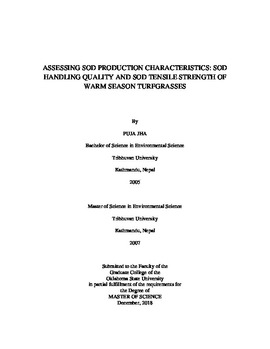| dc.contributor.advisor | Martin, Dennis Loren | |
| dc.contributor.author | Jha, Puja | |
| dc.date.accessioned | 2019-07-19T14:08:46Z | |
| dc.date.available | 2019-07-19T14:08:46Z | |
| dc.date.issued | 2018-12-01 | |
| dc.identifier.uri | https://hdl.handle.net/11244/320963 | |
| dc.description.abstract | Study I: The objective of this study was to assess the sod handling quality (SHQ) and sod tensile strength (STS) of entries grown at two heights (2.5 cm and 7.6 cm) in the 2016 NTEP Seashore Paspalum Trial at Stillwater, OK. Sod was harvested in July and September of 2017 at 12 and 14 months after planting, respectively. To assess SHQ and STS, two sod pads, each measuring 38 cm x 30.5 cm x 1.5 cm (length x width x depth), were cut from each replicate within each mowing height. The SHQ of each entry was assessed on a 1 to 5 visual scale where 1= very poor SHQ and 5=excellent SHQ. The STS was measured as the peak force required to cause sod pad tearing using a hand winch and force transducer/recorder system. Date of harvest had a significant effect upon the SHQ as well as STS. The main entry effect and date were found to have a significant effect upon the SHQ at p = 0.001. Significant date (p=0.001) and entry x date (p=0.001) were present with respect to STS. Mowing heights of 2.5 vs 7.6 cm did not produce a difference in small pad SHQ and STS. Average SHQ of the seashore paspalum entries ranged from 2.6 to 4.3. All entries except 'UGA Sr 14-1E' had an average SHQ greater than 3.0 which was considered the minimum acceptable quality for commercial sod production. The overall average SHQ and STS of entries was lower at 14 vs 12 MAP. However, 'UGP 73' had numerically greater STS at 14 than at 12 MAP. Additional research is needed to separate the effect of sod maturity versus possible negative impacts of harvesting sod late in the growing season after cool nights and short day lengths may have impacted seashore paspalum STS and SHQ. | |
| dc.description.abstract | Study II: The objective of this study was to assess the sod tensile strength (STS) and sod handling quality (SHQ) of experimental bermudagrass lines over time. Sod was harvested at 14 and 72 months after planting (MAP) with STS and SHQ assessed as discussed under Study I. There were highly significant (p=0.001) entry, date and entry x date effects for SHQ and STS. The SHQ and STS was unstable over time as average SHQ and STS fell from 70.1 kg dm-2 at 14 MAP to 16.7 kg dm-2 at 72 MAP. A strong positive correlation was found between sod handling quality and sod tensile strength (r=0.73 at p = 0.0001 at 14 MAP and r=0.92 at p = 0.0001 at 72 MAP.) at both harvest dates suggesting that sod handling quality as defined in prior published studies remains a broadly useful and reliable indicator of sod tensile strength for bermudagrass. | |
| dc.format | application/pdf | |
| dc.language | en_US | |
| dc.rights | Copyright is held by the author who has granted the Oklahoma State University Library the non-exclusive right to share this material in its institutional repository. Contact Digital Library Services at lib-dls@okstate.edu or 405-744-9161 for the permission policy on the use, reproduction or distribution of this material. | |
| dc.title | Assessing Sod Production Characteristics: Sod Handling Quality and Sod Tensile Strength of Warm Season Turfgrasses | |
| dc.contributor.committeeMember | Fontanier, Charles H. | |
| dc.contributor.committeeMember | Moss, Justin Quetone | |
| dc.contributor.committeeMember | Wu, Yanqi | |
| osu.filename | Jha_okstate_0664M_16005.pdf | |
| osu.accesstype | Open Access | |
| dc.description.department | Horticulture | |
| dc.type.genre | Thesis | |
| dc.type.material | Text | |
